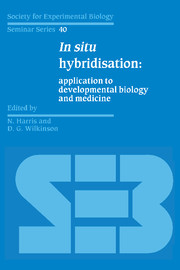Book contents
- Frontmatter
- Contents
- List of contributors
- Preface
- Non-radioisotopic labels for in situ hybridisation histochemistry: a histochemist's view.
- Use of haptenised nucleic acid probes in fluorescent in situ hybridisation
- The use of complementary RNA probes for the identification and localisation of peptide messenger RNA in the diffuse neuroendocrine system
- Contributions of the spatial analysis of gene expression to the study of sea urchin development
- Advantages and limitations of in situ hybridisation as exemplified by the molecular genetic analysis of Drosophila development
- The use of in situ hybridisation to study the localisation of maternal mRNAs during Xenopus oogenesis
- In situ hybridisation in the analysis of genes with potential roles in mouse embryogenesis
- Evolution of algal plastids from eukaryotic endosymbionts
- Localisation of expression of male flower-specific genes from maize by in situ hybridisation
- Tissue preparation techniques for in situ hybridisation studies of storage-protein gene expression during pea seed development
- Investigation of gene expression during plant gametogenesis by in situ hybridisation
- Sexing the human conceptus by in situ hybridisation
- Non-isotopic in situ hybridisation in human pathology
- The demonstration of viral DNA in human tissues by in situ DNA hybridisation
- Index
Investigation of gene expression during plant gametogenesis by in situ hybridisation
Published online by Cambridge University Press: 04 August 2010
- Frontmatter
- Contents
- List of contributors
- Preface
- Non-radioisotopic labels for in situ hybridisation histochemistry: a histochemist's view.
- Use of haptenised nucleic acid probes in fluorescent in situ hybridisation
- The use of complementary RNA probes for the identification and localisation of peptide messenger RNA in the diffuse neuroendocrine system
- Contributions of the spatial analysis of gene expression to the study of sea urchin development
- Advantages and limitations of in situ hybridisation as exemplified by the molecular genetic analysis of Drosophila development
- The use of in situ hybridisation to study the localisation of maternal mRNAs during Xenopus oogenesis
- In situ hybridisation in the analysis of genes with potential roles in mouse embryogenesis
- Evolution of algal plastids from eukaryotic endosymbionts
- Localisation of expression of male flower-specific genes from maize by in situ hybridisation
- Tissue preparation techniques for in situ hybridisation studies of storage-protein gene expression during pea seed development
- Investigation of gene expression during plant gametogenesis by in situ hybridisation
- Sexing the human conceptus by in situ hybridisation
- Non-isotopic in situ hybridisation in human pathology
- The demonstration of viral DNA in human tissues by in situ DNA hybridisation
- Index
Summary
Introduction
The study of the genes responsible for pollen and ovule development has long been frustrated by the fact that the cells concerned are embedded deep in the sporophytic tissue. The situation is further complicated by their investment by actively transcribing nurse tissues – the tapetum and nucellus. In situ hybridisation thus represents the only approach by which gene expression may be studied in these systems. However, the resolution offered by isotopic methods is insufficient to distinguish between members of the microscope tetrad, or individual cells of the developing embryosac. For this reason non-isotopic techniques have been investigated and a protocol devised for anthers. Enzymic detection systems can be used, but high endogenous levels of phosphatase makes blocking and other pretreatments often essential. Further, the methods normally employed to fix and embed material for in situ work do not give good results with reproductive cells, principally because of their small size and fragility. The use of resins as embedding media has therefore been explored.
The problems posed by plant reproductive systems
The cells involved in male and female gametogenesis in higher plants are unusual in a number of ways. Firstly, they are comparatively few in number and are surrounded by other tissues carrying out radically different functions. Secondly, they undergo a complex programme of differentiation and division leading to the formation of a number of highly differentiated daughter cells. Thirdly, this development takes place comparatively rapidly, with the cells passing from stage to stage in hours, rather than days as is normally the case for plants.
- Type
- Chapter
- Information
- In Situ HybridisationApplication to Developmental Biology and Medicine, pp. 189 - 204Publisher: Cambridge University PressPrint publication year: 1990
- 3
- Cited by



